Auditing Report: API Financial Statement Audit and Risks
VerifiedAdded on 2023/03/20
|19
|3629
|98
Report
AI Summary
This report presents an in-depth analysis of the auditing process applied to Always Precise Instruments Private Limited (API). It begins with an examination of audit risks identified through ratio analysis, including current ratio, quick asset ratio, return on equity, return on total assets, gross margin, marketing expenses, administrative expenses, times interest earned, days in inventory, days in receivable accounts, and debt-to-equity ratio. Each ratio is evaluated for potential misstatements and corresponding audit procedures are suggested. The report then investigates inventory control loopholes, detailing weaknesses in the internal control system and their associated audit risks and procedures. Finally, it explains the methods of sampling required for auditing API, providing a comprehensive guide for financial statement analysis and risk mitigation.
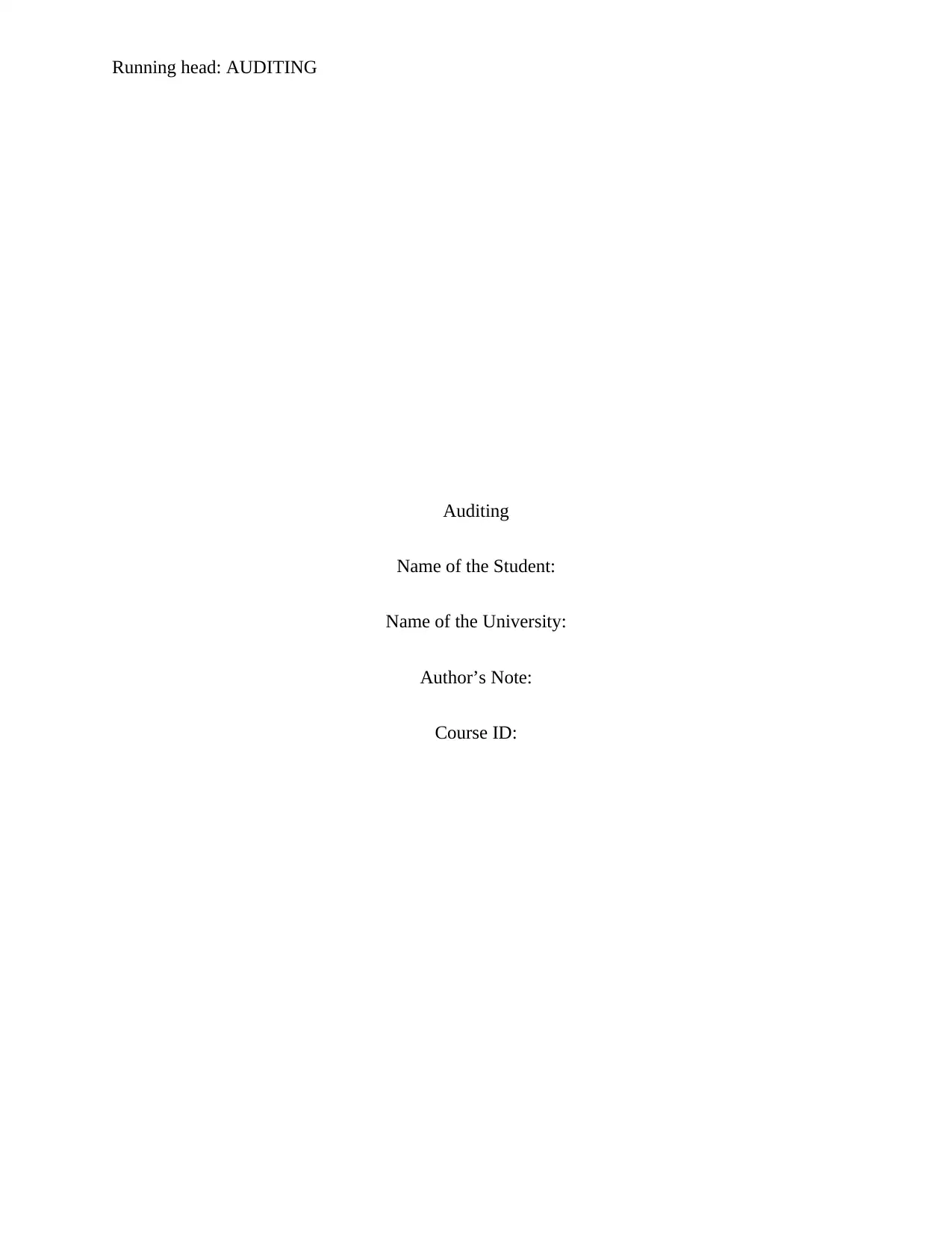
Running head: AUDITING
Auditing
Name of the Student:
Name of the University:
Author’s Note:
Course ID:
Auditing
Name of the Student:
Name of the University:
Author’s Note:
Course ID:
Paraphrase This Document
Need a fresh take? Get an instant paraphrase of this document with our AI Paraphraser
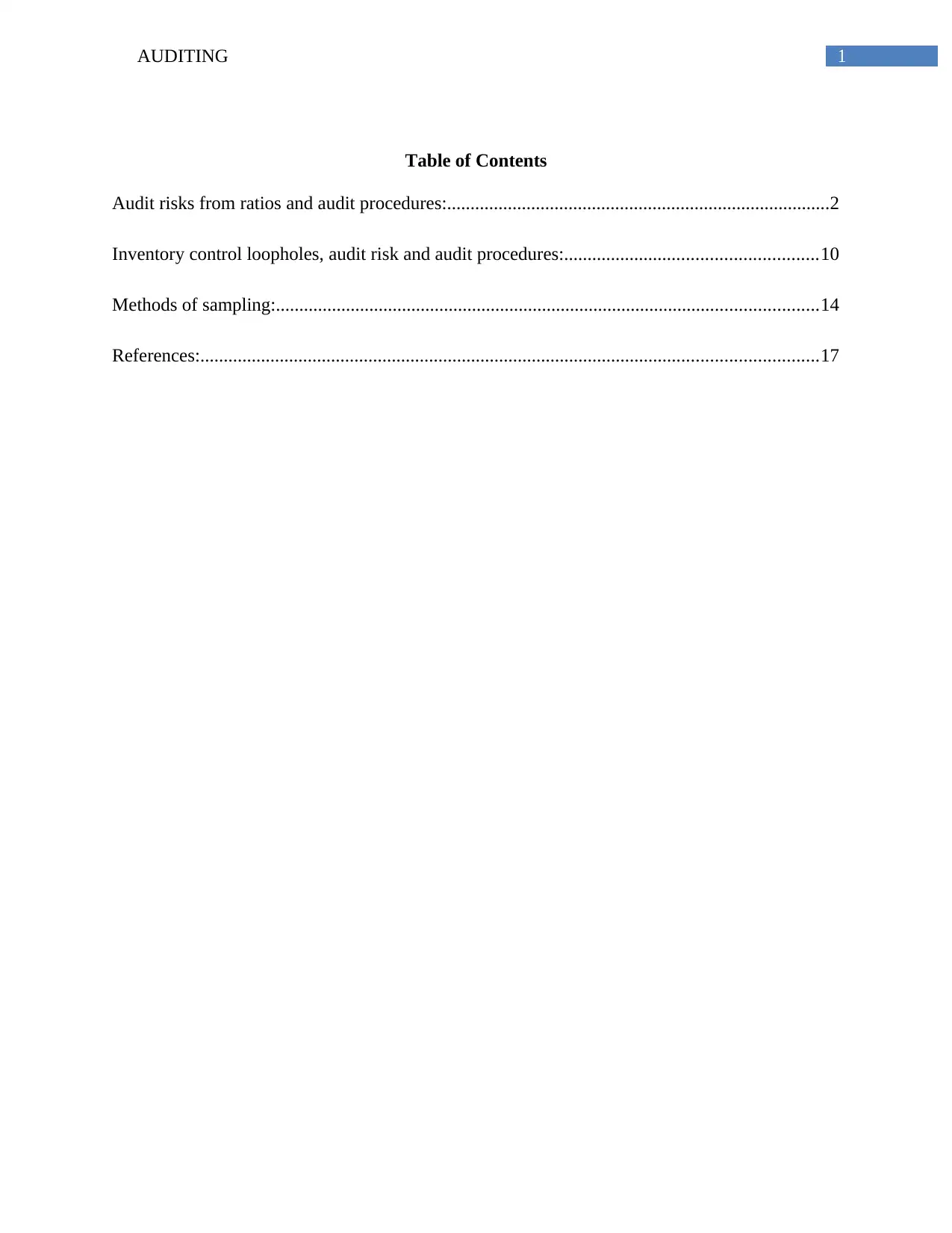
1AUDITING
Table of Contents
Audit risks from ratios and audit procedures:..................................................................................2
Inventory control loopholes, audit risk and audit procedures:......................................................10
Methods of sampling:....................................................................................................................14
References:....................................................................................................................................17
Table of Contents
Audit risks from ratios and audit procedures:..................................................................................2
Inventory control loopholes, audit risk and audit procedures:......................................................10
Methods of sampling:....................................................................................................................14
References:....................................................................................................................................17
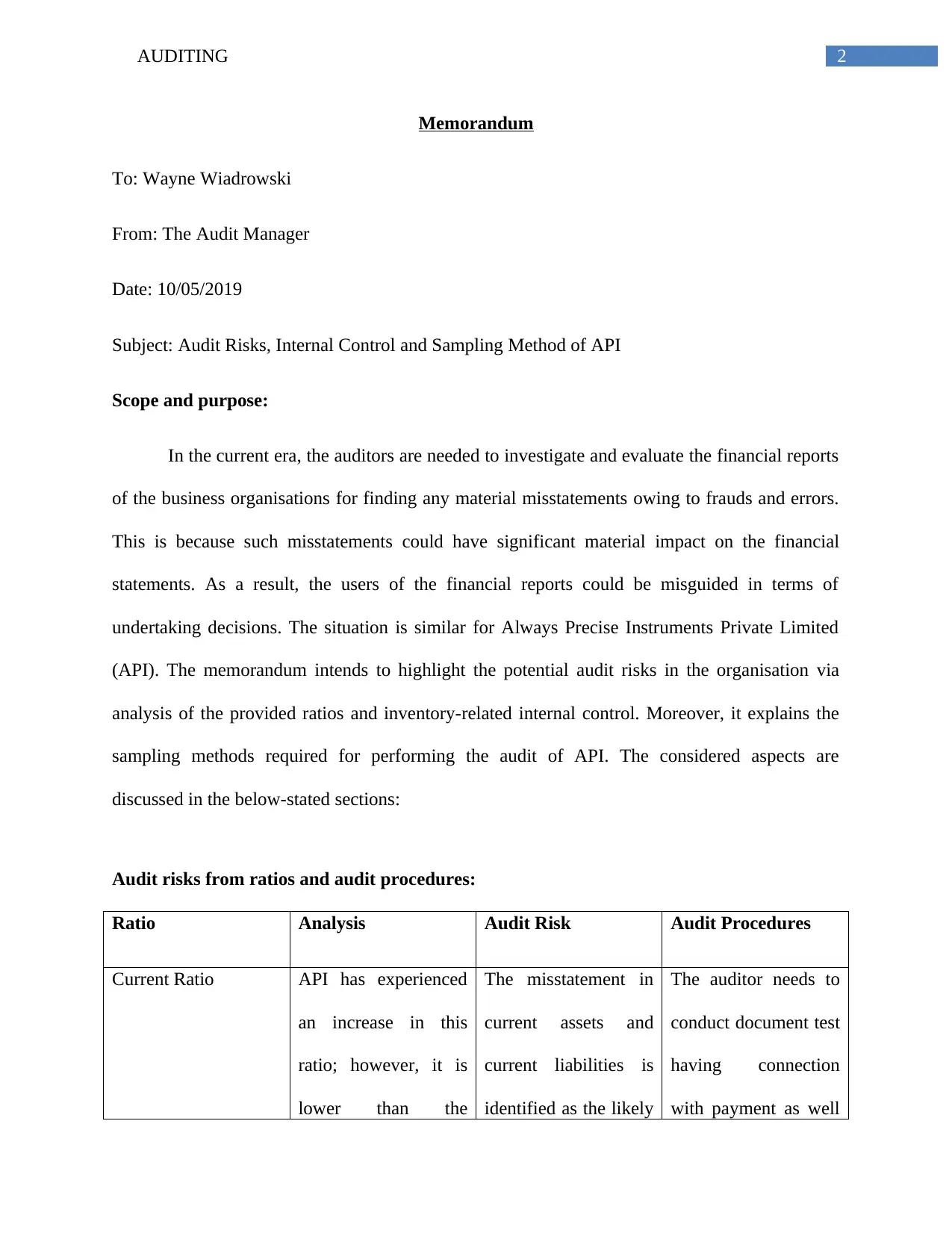
2AUDITING
Memorandum
To: Wayne Wiadrowski
From: The Audit Manager
Date: 10/05/2019
Subject: Audit Risks, Internal Control and Sampling Method of API
Scope and purpose:
In the current era, the auditors are needed to investigate and evaluate the financial reports
of the business organisations for finding any material misstatements owing to frauds and errors.
This is because such misstatements could have significant material impact on the financial
statements. As a result, the users of the financial reports could be misguided in terms of
undertaking decisions. The situation is similar for Always Precise Instruments Private Limited
(API). The memorandum intends to highlight the potential audit risks in the organisation via
analysis of the provided ratios and inventory-related internal control. Moreover, it explains the
sampling methods required for performing the audit of API. The considered aspects are
discussed in the below-stated sections:
Audit risks from ratios and audit procedures:
Ratio Analysis Audit Risk Audit Procedures
Current Ratio API has experienced
an increase in this
ratio; however, it is
lower than the
The misstatement in
current assets and
current liabilities is
identified as the likely
The auditor needs to
conduct document test
having connection
with payment as well
Memorandum
To: Wayne Wiadrowski
From: The Audit Manager
Date: 10/05/2019
Subject: Audit Risks, Internal Control and Sampling Method of API
Scope and purpose:
In the current era, the auditors are needed to investigate and evaluate the financial reports
of the business organisations for finding any material misstatements owing to frauds and errors.
This is because such misstatements could have significant material impact on the financial
statements. As a result, the users of the financial reports could be misguided in terms of
undertaking decisions. The situation is similar for Always Precise Instruments Private Limited
(API). The memorandum intends to highlight the potential audit risks in the organisation via
analysis of the provided ratios and inventory-related internal control. Moreover, it explains the
sampling methods required for performing the audit of API. The considered aspects are
discussed in the below-stated sections:
Audit risks from ratios and audit procedures:
Ratio Analysis Audit Risk Audit Procedures
Current Ratio API has experienced
an increase in this
ratio; however, it is
lower than the
The misstatement in
current assets and
current liabilities is
identified as the likely
The auditor needs to
conduct document test
having connection
with payment as well
⊘ This is a preview!⊘
Do you want full access?
Subscribe today to unlock all pages.

Trusted by 1+ million students worldwide
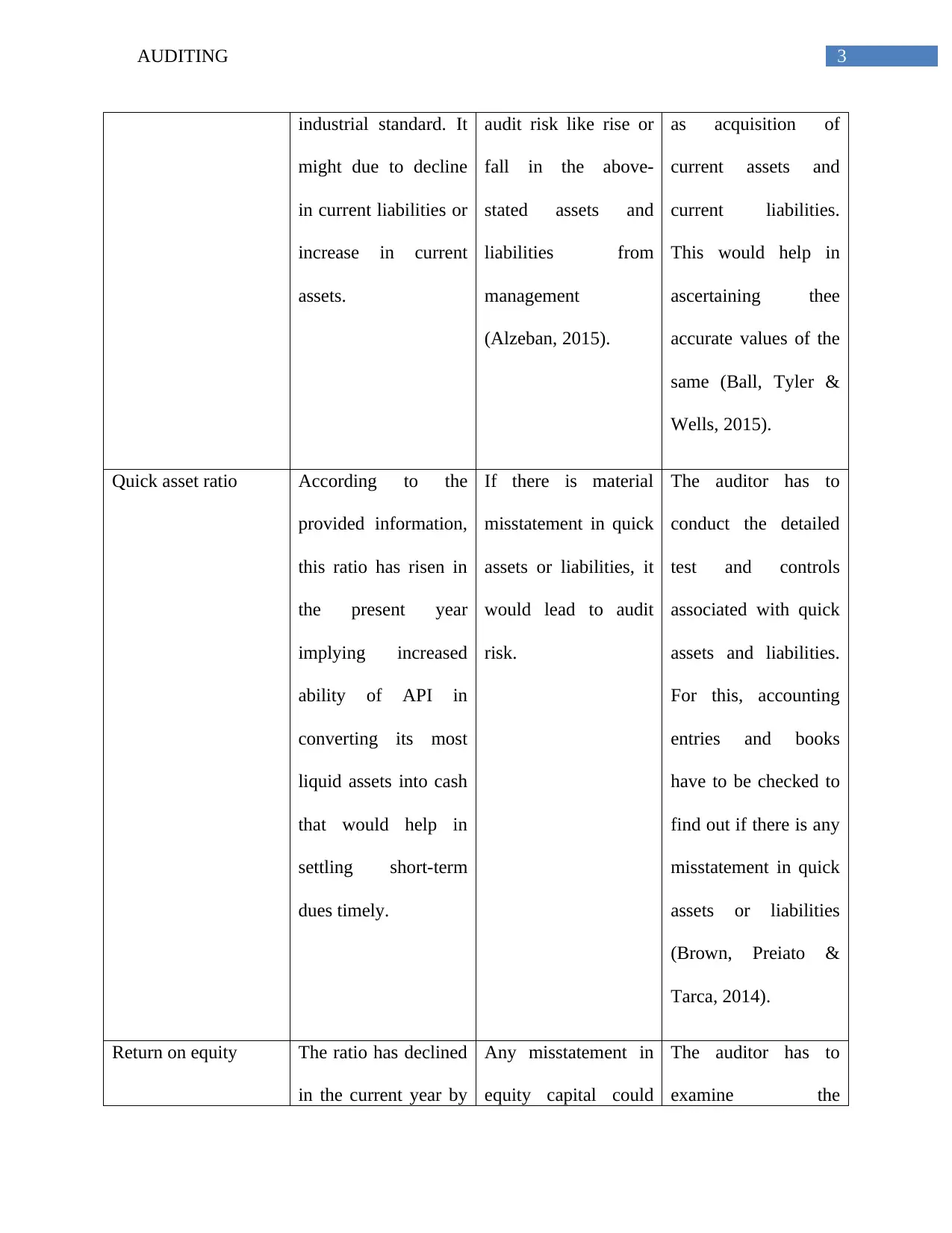
3AUDITING
industrial standard. It
might due to decline
in current liabilities or
increase in current
assets.
audit risk like rise or
fall in the above-
stated assets and
liabilities from
management
(Alzeban, 2015).
as acquisition of
current assets and
current liabilities.
This would help in
ascertaining thee
accurate values of the
same (Ball, Tyler &
Wells, 2015).
Quick asset ratio According to the
provided information,
this ratio has risen in
the present year
implying increased
ability of API in
converting its most
liquid assets into cash
that would help in
settling short-term
dues timely.
If there is material
misstatement in quick
assets or liabilities, it
would lead to audit
risk.
The auditor has to
conduct the detailed
test and controls
associated with quick
assets and liabilities.
For this, accounting
entries and books
have to be checked to
find out if there is any
misstatement in quick
assets or liabilities
(Brown, Preiato &
Tarca, 2014).
Return on equity The ratio has declined
in the current year by
Any misstatement in
equity capital could
The auditor has to
examine the
industrial standard. It
might due to decline
in current liabilities or
increase in current
assets.
audit risk like rise or
fall in the above-
stated assets and
liabilities from
management
(Alzeban, 2015).
as acquisition of
current assets and
current liabilities.
This would help in
ascertaining thee
accurate values of the
same (Ball, Tyler &
Wells, 2015).
Quick asset ratio According to the
provided information,
this ratio has risen in
the present year
implying increased
ability of API in
converting its most
liquid assets into cash
that would help in
settling short-term
dues timely.
If there is material
misstatement in quick
assets or liabilities, it
would lead to audit
risk.
The auditor has to
conduct the detailed
test and controls
associated with quick
assets and liabilities.
For this, accounting
entries and books
have to be checked to
find out if there is any
misstatement in quick
assets or liabilities
(Brown, Preiato &
Tarca, 2014).
Return on equity The ratio has declined
in the current year by
Any misstatement in
equity capital could
The auditor has to
examine the
Paraphrase This Document
Need a fresh take? Get an instant paraphrase of this document with our AI Paraphraser
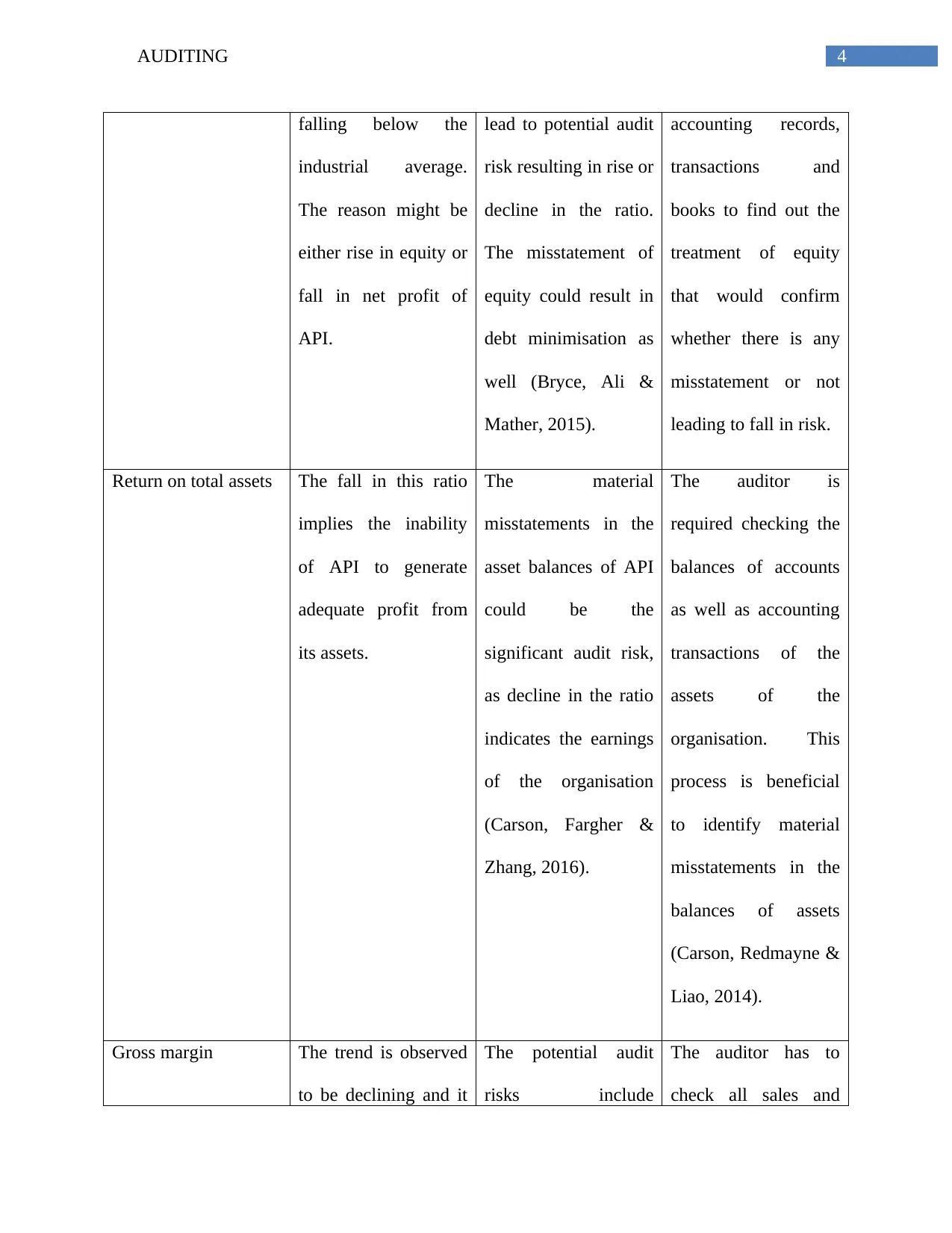
4AUDITING
falling below the
industrial average.
The reason might be
either rise in equity or
fall in net profit of
API.
lead to potential audit
risk resulting in rise or
decline in the ratio.
The misstatement of
equity could result in
debt minimisation as
well (Bryce, Ali &
Mather, 2015).
accounting records,
transactions and
books to find out the
treatment of equity
that would confirm
whether there is any
misstatement or not
leading to fall in risk.
Return on total assets The fall in this ratio
implies the inability
of API to generate
adequate profit from
its assets.
The material
misstatements in the
asset balances of API
could be the
significant audit risk,
as decline in the ratio
indicates the earnings
of the organisation
(Carson, Fargher &
Zhang, 2016).
The auditor is
required checking the
balances of accounts
as well as accounting
transactions of the
assets of the
organisation. This
process is beneficial
to identify material
misstatements in the
balances of assets
(Carson, Redmayne &
Liao, 2014).
Gross margin The trend is observed
to be declining and it
The potential audit
risks include
The auditor has to
check all sales and
falling below the
industrial average.
The reason might be
either rise in equity or
fall in net profit of
API.
lead to potential audit
risk resulting in rise or
decline in the ratio.
The misstatement of
equity could result in
debt minimisation as
well (Bryce, Ali &
Mather, 2015).
accounting records,
transactions and
books to find out the
treatment of equity
that would confirm
whether there is any
misstatement or not
leading to fall in risk.
Return on total assets The fall in this ratio
implies the inability
of API to generate
adequate profit from
its assets.
The material
misstatements in the
asset balances of API
could be the
significant audit risk,
as decline in the ratio
indicates the earnings
of the organisation
(Carson, Fargher &
Zhang, 2016).
The auditor is
required checking the
balances of accounts
as well as accounting
transactions of the
assets of the
organisation. This
process is beneficial
to identify material
misstatements in the
balances of assets
(Carson, Redmayne &
Liao, 2014).
Gross margin The trend is observed
to be declining and it
The potential audit
risks include
The auditor has to
check all sales and
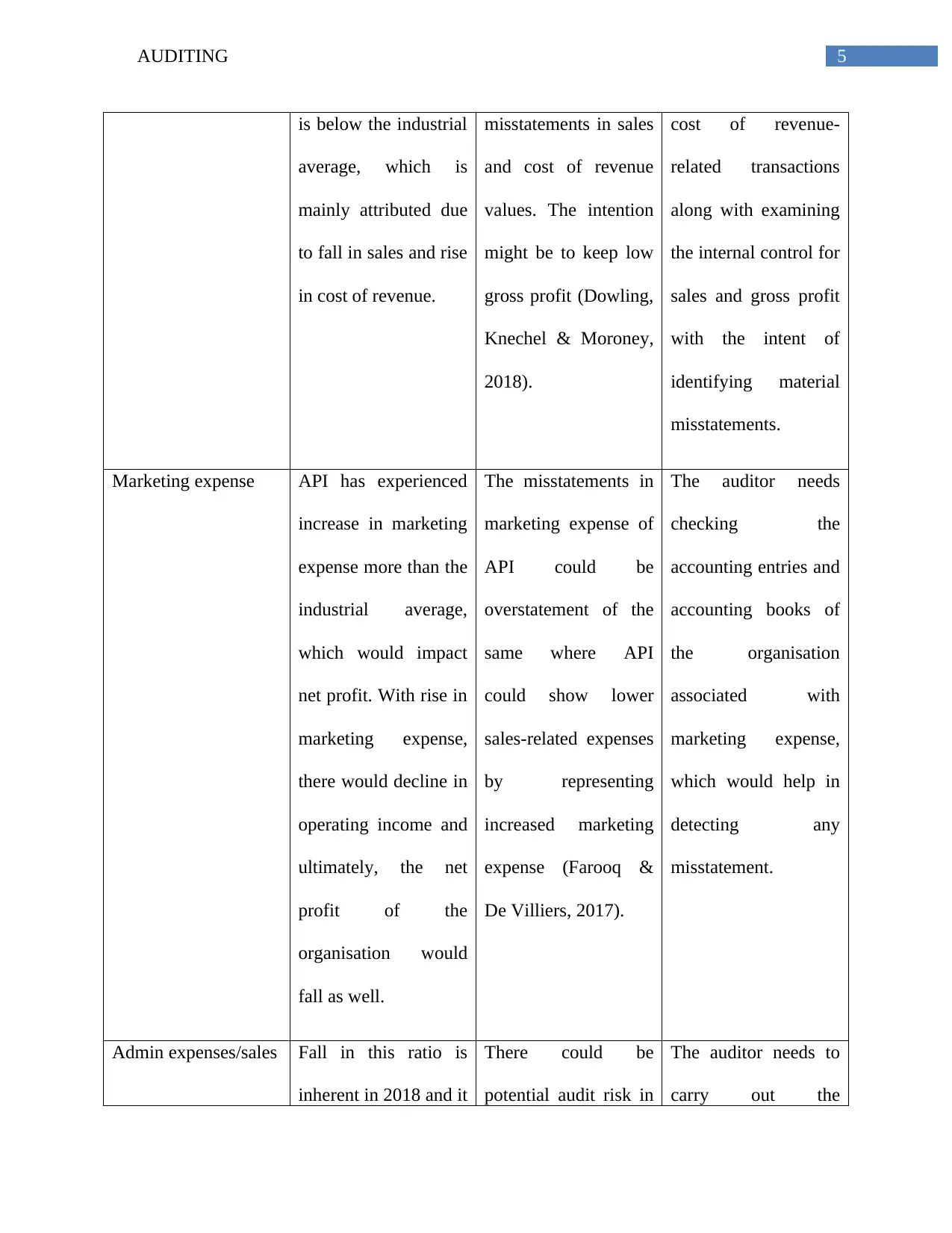
5AUDITING
is below the industrial
average, which is
mainly attributed due
to fall in sales and rise
in cost of revenue.
misstatements in sales
and cost of revenue
values. The intention
might be to keep low
gross profit (Dowling,
Knechel & Moroney,
2018).
cost of revenue-
related transactions
along with examining
the internal control for
sales and gross profit
with the intent of
identifying material
misstatements.
Marketing expense API has experienced
increase in marketing
expense more than the
industrial average,
which would impact
net profit. With rise in
marketing expense,
there would decline in
operating income and
ultimately, the net
profit of the
organisation would
fall as well.
The misstatements in
marketing expense of
API could be
overstatement of the
same where API
could show lower
sales-related expenses
by representing
increased marketing
expense (Farooq &
De Villiers, 2017).
The auditor needs
checking the
accounting entries and
accounting books of
the organisation
associated with
marketing expense,
which would help in
detecting any
misstatement.
Admin expenses/sales Fall in this ratio is
inherent in 2018 and it
There could be
potential audit risk in
The auditor needs to
carry out the
is below the industrial
average, which is
mainly attributed due
to fall in sales and rise
in cost of revenue.
misstatements in sales
and cost of revenue
values. The intention
might be to keep low
gross profit (Dowling,
Knechel & Moroney,
2018).
cost of revenue-
related transactions
along with examining
the internal control for
sales and gross profit
with the intent of
identifying material
misstatements.
Marketing expense API has experienced
increase in marketing
expense more than the
industrial average,
which would impact
net profit. With rise in
marketing expense,
there would decline in
operating income and
ultimately, the net
profit of the
organisation would
fall as well.
The misstatements in
marketing expense of
API could be
overstatement of the
same where API
could show lower
sales-related expenses
by representing
increased marketing
expense (Farooq &
De Villiers, 2017).
The auditor needs
checking the
accounting entries and
accounting books of
the organisation
associated with
marketing expense,
which would help in
detecting any
misstatement.
Admin expenses/sales Fall in this ratio is
inherent in 2018 and it
There could be
potential audit risk in
The auditor needs to
carry out the
⊘ This is a preview!⊘
Do you want full access?
Subscribe today to unlock all pages.

Trusted by 1+ million students worldwide
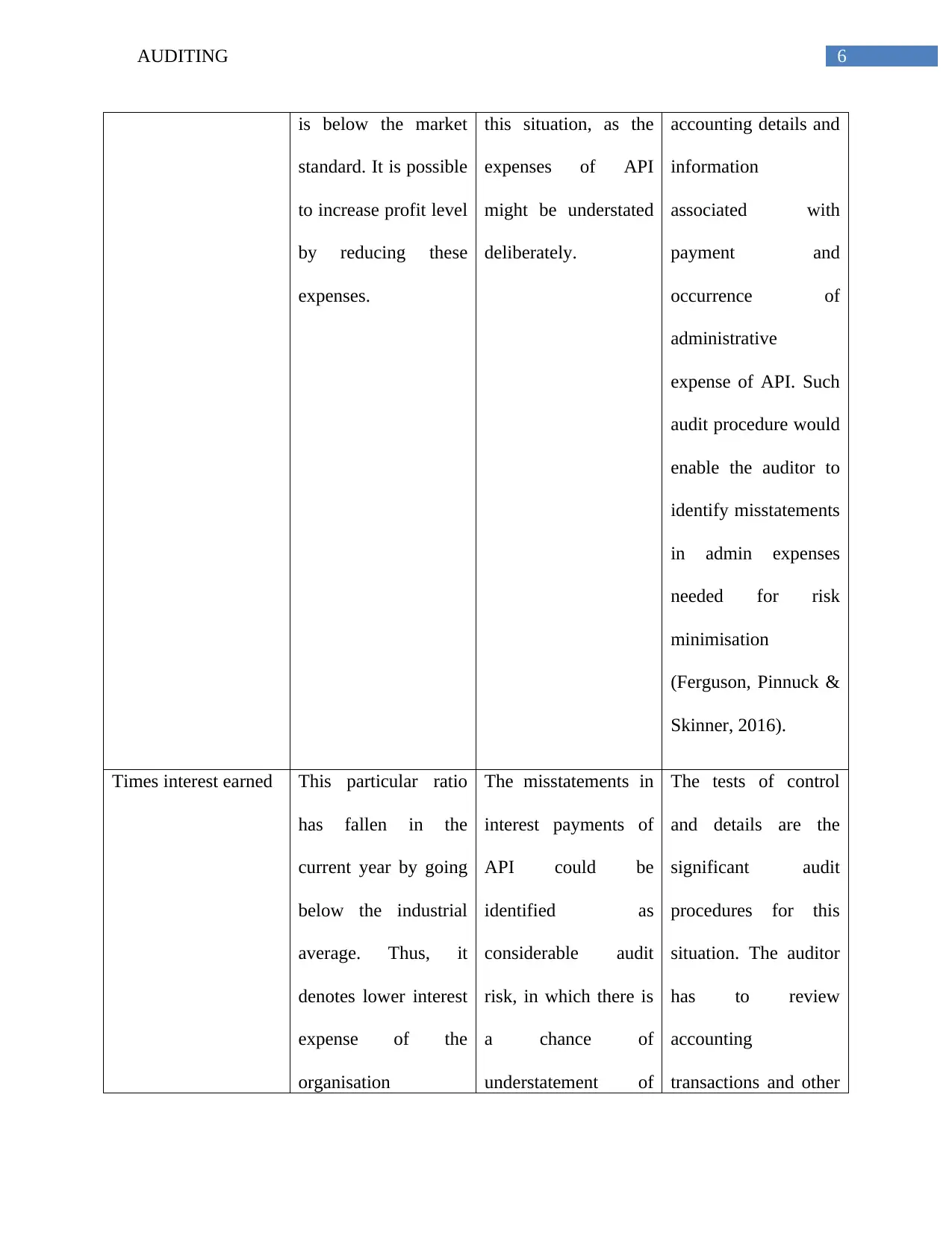
6AUDITING
is below the market
standard. It is possible
to increase profit level
by reducing these
expenses.
this situation, as the
expenses of API
might be understated
deliberately.
accounting details and
information
associated with
payment and
occurrence of
administrative
expense of API. Such
audit procedure would
enable the auditor to
identify misstatements
in admin expenses
needed for risk
minimisation
(Ferguson, Pinnuck &
Skinner, 2016).
Times interest earned This particular ratio
has fallen in the
current year by going
below the industrial
average. Thus, it
denotes lower interest
expense of the
organisation
The misstatements in
interest payments of
API could be
identified as
considerable audit
risk, in which there is
a chance of
understatement of
The tests of control
and details are the
significant audit
procedures for this
situation. The auditor
has to review
accounting
transactions and other
is below the market
standard. It is possible
to increase profit level
by reducing these
expenses.
this situation, as the
expenses of API
might be understated
deliberately.
accounting details and
information
associated with
payment and
occurrence of
administrative
expense of API. Such
audit procedure would
enable the auditor to
identify misstatements
in admin expenses
needed for risk
minimisation
(Ferguson, Pinnuck &
Skinner, 2016).
Times interest earned This particular ratio
has fallen in the
current year by going
below the industrial
average. Thus, it
denotes lower interest
expense of the
organisation
The misstatements in
interest payments of
API could be
identified as
considerable audit
risk, in which there is
a chance of
understatement of
The tests of control
and details are the
significant audit
procedures for this
situation. The auditor
has to review
accounting
transactions and other
Paraphrase This Document
Need a fresh take? Get an instant paraphrase of this document with our AI Paraphraser

7AUDITING
compared to the past
year. The inability to
manage considerable
earnings could be the
reason.
interest expense
leading to minimised
interest payment.
information related to
interest expense.
Therefore, the
misstatements would
be identified in the
interest expenses of
the organisation (Gay
& Simnett, 2017).
Days in inventory There is fall in
inventory days of API
in 2018 where the
organisation has
undertaken additional
time for settling its
inventory in the
existing year.
The significant
misstatements in the
closing balances of
inventory in API
could be the potential
audit risk. Therefore,
there is chance of
closing inventory
overstatement that
could minimise gross
profit.
The control test is the
major audit procedure
for the potential audit
risk, in which the
auditor is required
testing the process of
internal control of the
organisation. With the
help of such test, the
auditors would have
the scope of
identifying
misstatements in stock
in order to reduce risk
(Hay, Stewart &
compared to the past
year. The inability to
manage considerable
earnings could be the
reason.
interest expense
leading to minimised
interest payment.
information related to
interest expense.
Therefore, the
misstatements would
be identified in the
interest expenses of
the organisation (Gay
& Simnett, 2017).
Days in inventory There is fall in
inventory days of API
in 2018 where the
organisation has
undertaken additional
time for settling its
inventory in the
existing year.
The significant
misstatements in the
closing balances of
inventory in API
could be the potential
audit risk. Therefore,
there is chance of
closing inventory
overstatement that
could minimise gross
profit.
The control test is the
major audit procedure
for the potential audit
risk, in which the
auditor is required
testing the process of
internal control of the
organisation. With the
help of such test, the
auditors would have
the scope of
identifying
misstatements in stock
in order to reduce risk
(Hay, Stewart &

8AUDITING
Botica Redmayne,
2017).
Days in accounts
receivable
Days in accounts
receivable of API
have increased in the
existing year. This
implies decline in
accounts receivable
turnover ratio of the
organisation in the
existing period.
The potential audit
risk includes accounts
receivable balances,
which could have
been overstated in the
present year owing to
weakness in internal
control and other
influential dynamics.
The tests of control
and details are the
significant audit
procedures, which
have to be applied in
this situation. In
accordance with the
processes, the auditors
need to test internal
control of the
organisation
associated with
accounts receivable
and accounting
records such as
transactions and
others associated with
accounts receivable to
be tested in the
current year. This
would assist in
Botica Redmayne,
2017).
Days in accounts
receivable
Days in accounts
receivable of API
have increased in the
existing year. This
implies decline in
accounts receivable
turnover ratio of the
organisation in the
existing period.
The potential audit
risk includes accounts
receivable balances,
which could have
been overstated in the
present year owing to
weakness in internal
control and other
influential dynamics.
The tests of control
and details are the
significant audit
procedures, which
have to be applied in
this situation. In
accordance with the
processes, the auditors
need to test internal
control of the
organisation
associated with
accounts receivable
and accounting
records such as
transactions and
others associated with
accounts receivable to
be tested in the
current year. This
would assist in
⊘ This is a preview!⊘
Do you want full access?
Subscribe today to unlock all pages.

Trusted by 1+ million students worldwide
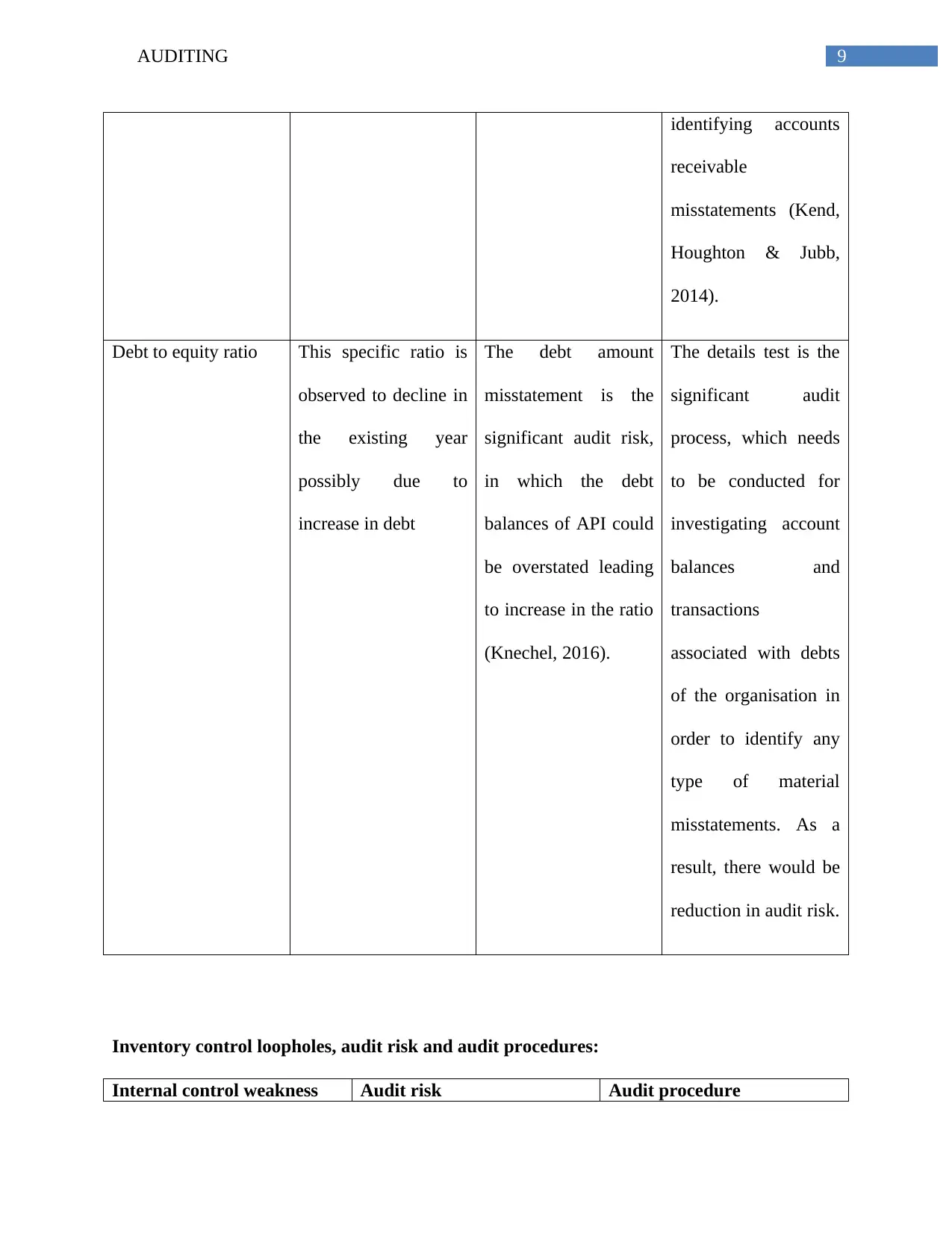
9AUDITING
identifying accounts
receivable
misstatements (Kend,
Houghton & Jubb,
2014).
Debt to equity ratio This specific ratio is
observed to decline in
the existing year
possibly due to
increase in debt
The debt amount
misstatement is the
significant audit risk,
in which the debt
balances of API could
be overstated leading
to increase in the ratio
(Knechel, 2016).
The details test is the
significant audit
process, which needs
to be conducted for
investigating account
balances and
transactions
associated with debts
of the organisation in
order to identify any
type of material
misstatements. As a
result, there would be
reduction in audit risk.
Inventory control loopholes, audit risk and audit procedures:
Internal control weakness Audit risk Audit procedure
identifying accounts
receivable
misstatements (Kend,
Houghton & Jubb,
2014).
Debt to equity ratio This specific ratio is
observed to decline in
the existing year
possibly due to
increase in debt
The debt amount
misstatement is the
significant audit risk,
in which the debt
balances of API could
be overstated leading
to increase in the ratio
(Knechel, 2016).
The details test is the
significant audit
process, which needs
to be conducted for
investigating account
balances and
transactions
associated with debts
of the organisation in
order to identify any
type of material
misstatements. As a
result, there would be
reduction in audit risk.
Inventory control loopholes, audit risk and audit procedures:
Internal control weakness Audit risk Audit procedure
Paraphrase This Document
Need a fresh take? Get an instant paraphrase of this document with our AI Paraphraser
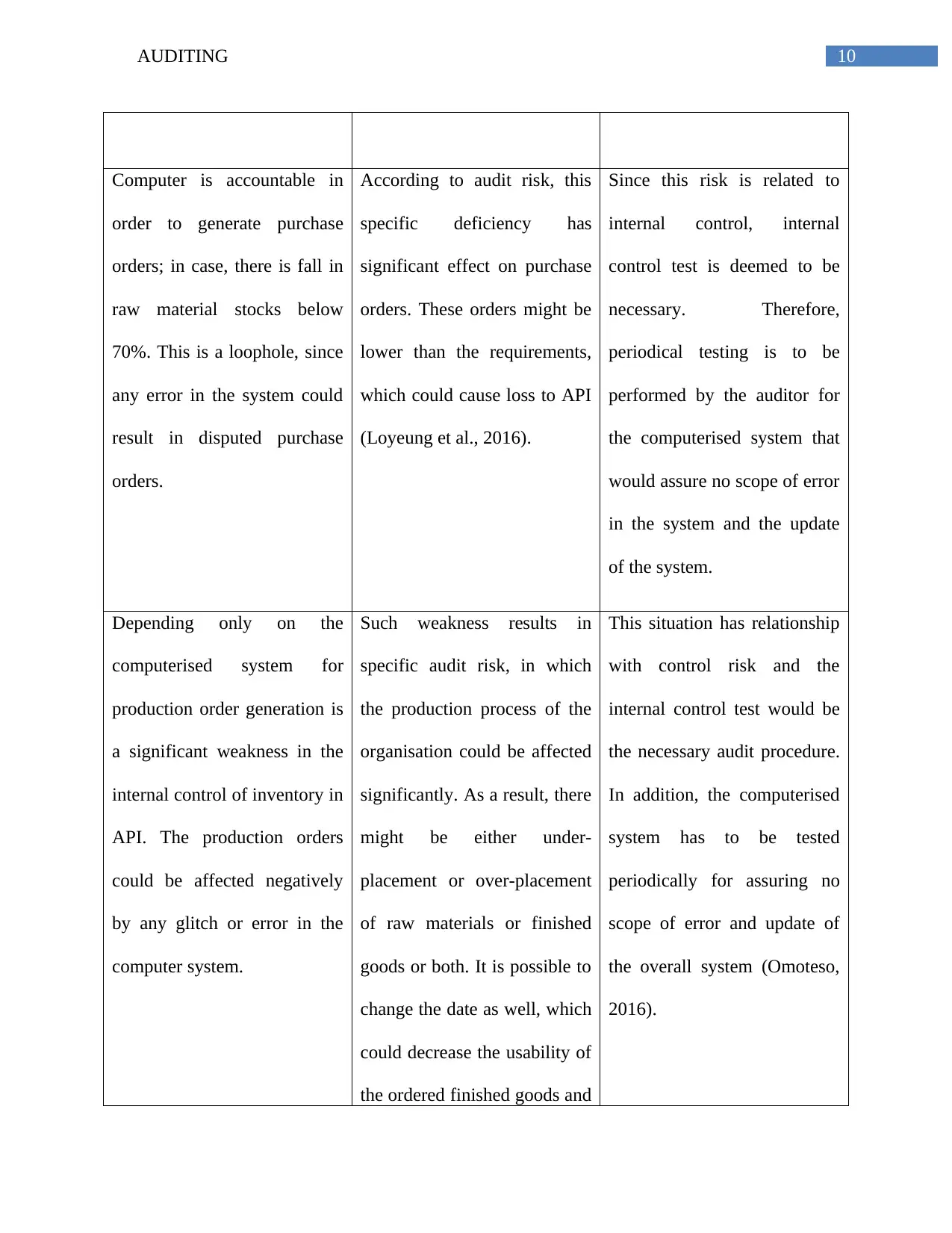
10AUDITING
Computer is accountable in
order to generate purchase
orders; in case, there is fall in
raw material stocks below
70%. This is a loophole, since
any error in the system could
result in disputed purchase
orders.
According to audit risk, this
specific deficiency has
significant effect on purchase
orders. These orders might be
lower than the requirements,
which could cause loss to API
(Loyeung et al., 2016).
Since this risk is related to
internal control, internal
control test is deemed to be
necessary. Therefore,
periodical testing is to be
performed by the auditor for
the computerised system that
would assure no scope of error
in the system and the update
of the system.
Depending only on the
computerised system for
production order generation is
a significant weakness in the
internal control of inventory in
API. The production orders
could be affected negatively
by any glitch or error in the
computer system.
Such weakness results in
specific audit risk, in which
the production process of the
organisation could be affected
significantly. As a result, there
might be either under-
placement or over-placement
of raw materials or finished
goods or both. It is possible to
change the date as well, which
could decrease the usability of
the ordered finished goods and
This situation has relationship
with control risk and the
internal control test would be
the necessary audit procedure.
In addition, the computerised
system has to be tested
periodically for assuring no
scope of error and update of
the overall system (Omoteso,
2016).
Computer is accountable in
order to generate purchase
orders; in case, there is fall in
raw material stocks below
70%. This is a loophole, since
any error in the system could
result in disputed purchase
orders.
According to audit risk, this
specific deficiency has
significant effect on purchase
orders. These orders might be
lower than the requirements,
which could cause loss to API
(Loyeung et al., 2016).
Since this risk is related to
internal control, internal
control test is deemed to be
necessary. Therefore,
periodical testing is to be
performed by the auditor for
the computerised system that
would assure no scope of error
in the system and the update
of the system.
Depending only on the
computerised system for
production order generation is
a significant weakness in the
internal control of inventory in
API. The production orders
could be affected negatively
by any glitch or error in the
computer system.
Such weakness results in
specific audit risk, in which
the production process of the
organisation could be affected
significantly. As a result, there
might be either under-
placement or over-placement
of raw materials or finished
goods or both. It is possible to
change the date as well, which
could decrease the usability of
the ordered finished goods and
This situation has relationship
with control risk and the
internal control test would be
the necessary audit procedure.
In addition, the computerised
system has to be tested
periodically for assuring no
scope of error and update of
the overall system (Omoteso,
2016).
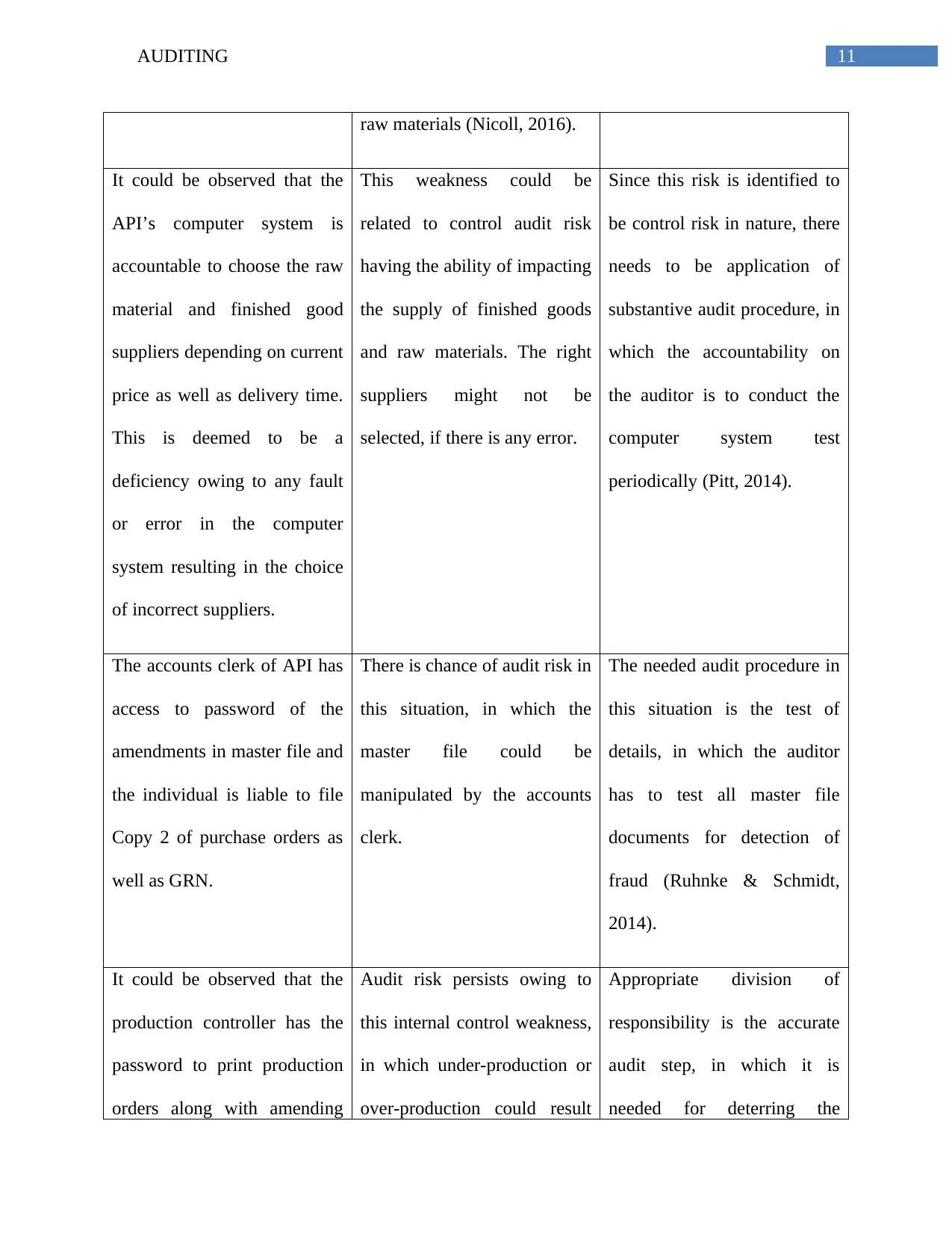
11AUDITING
raw materials (Nicoll, 2016).
It could be observed that the
API’s computer system is
accountable to choose the raw
material and finished good
suppliers depending on current
price as well as delivery time.
This is deemed to be a
deficiency owing to any fault
or error in the computer
system resulting in the choice
of incorrect suppliers.
This weakness could be
related to control audit risk
having the ability of impacting
the supply of finished goods
and raw materials. The right
suppliers might not be
selected, if there is any error.
Since this risk is identified to
be control risk in nature, there
needs to be application of
substantive audit procedure, in
which the accountability on
the auditor is to conduct the
computer system test
periodically (Pitt, 2014).
The accounts clerk of API has
access to password of the
amendments in master file and
the individual is liable to file
Copy 2 of purchase orders as
well as GRN.
There is chance of audit risk in
this situation, in which the
master file could be
manipulated by the accounts
clerk.
The needed audit procedure in
this situation is the test of
details, in which the auditor
has to test all master file
documents for detection of
fraud (Ruhnke & Schmidt,
2014).
It could be observed that the
production controller has the
password to print production
orders along with amending
Audit risk persists owing to
this internal control weakness,
in which under-production or
over-production could result
Appropriate division of
responsibility is the accurate
audit step, in which it is
needed for deterring the
raw materials (Nicoll, 2016).
It could be observed that the
API’s computer system is
accountable to choose the raw
material and finished good
suppliers depending on current
price as well as delivery time.
This is deemed to be a
deficiency owing to any fault
or error in the computer
system resulting in the choice
of incorrect suppliers.
This weakness could be
related to control audit risk
having the ability of impacting
the supply of finished goods
and raw materials. The right
suppliers might not be
selected, if there is any error.
Since this risk is identified to
be control risk in nature, there
needs to be application of
substantive audit procedure, in
which the accountability on
the auditor is to conduct the
computer system test
periodically (Pitt, 2014).
The accounts clerk of API has
access to password of the
amendments in master file and
the individual is liable to file
Copy 2 of purchase orders as
well as GRN.
There is chance of audit risk in
this situation, in which the
master file could be
manipulated by the accounts
clerk.
The needed audit procedure in
this situation is the test of
details, in which the auditor
has to test all master file
documents for detection of
fraud (Ruhnke & Schmidt,
2014).
It could be observed that the
production controller has the
password to print production
orders along with amending
Audit risk persists owing to
this internal control weakness,
in which under-production or
over-production could result
Appropriate division of
responsibility is the accurate
audit step, in which it is
needed for deterring the
⊘ This is a preview!⊘
Do you want full access?
Subscribe today to unlock all pages.

Trusted by 1+ million students worldwide
1 out of 19